Spring Bulb Planting, Design & Care Guide
Discover how to plant, design & care for spring bulbs in the UK. Expert tips, seasonal guides, and trusted bulb suppliers for stunning blooms
Spring bulb planting brings a burst of colour after a long winter and sets the tone for how lively and welcoming your garden looks throughout the year. Well-chosen bulbs can shape your garden’s mood, whether you’re after bold patches of tulips or gentle carpets of snowdrops. There’s a bit of timing and care involved, but with the right approach, you’ll get a display that keeps coming back stronger every spring.
Hello & welcome, I’m a Hampshire gardener who’s spent most of my life outdoors, inspired by a childhood surrounded by countryside and parents who loved their allotments. For the past five years I’ve been working as a self-employed gardener, growing my skills through hands-on experience, plenty of research, and a genuine passion for watching gardens change through the seasons. Now I share what I’ve learned to help others enjoy creating beautiful, thriving outdoor spaces of their own.
Garden Nest Living grew from a simple idea: to share my love of gardens and creating calm, beautiful spaces, both inside and out. When you buy through my affiliate links, you are allowing me to keep sharing inspiration, ideas and products… at no extra cost to you. Thank you for being a part of my journey!
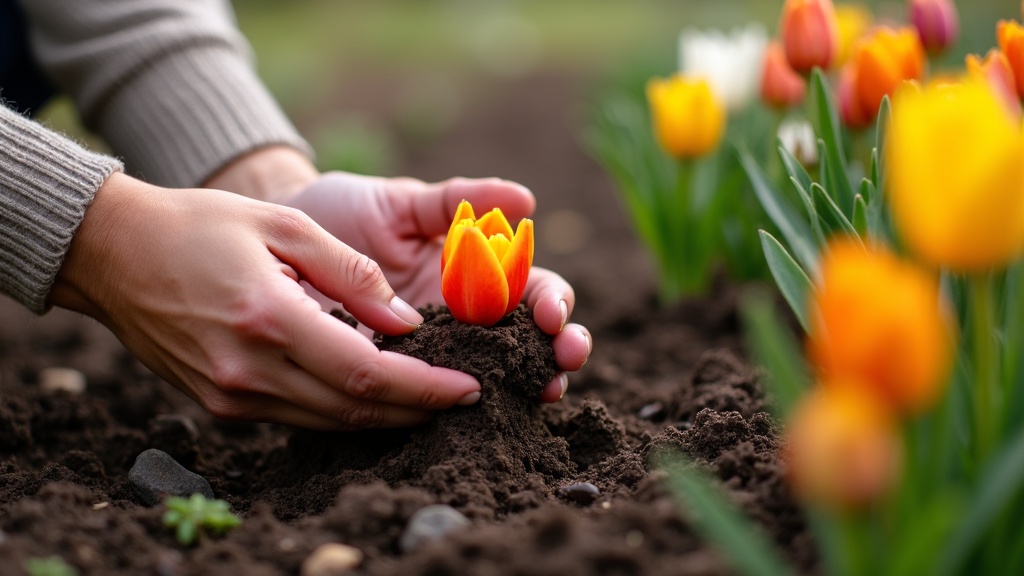
Popular Types of Spring Bulbs in the UK
Spring bulbs are pretty awesome for adding early colour to borders, containers, and lawns, just when most perennials are barely waking up. I enjoy how flexible bulbs can be. They brighten spring beds, make walks feel inviting, and layer gardens with all sorts of heights and scents.
Here is a list of the most popular Sping Bulbs in the UK:
Early Spring Bulbs
Winter Aconites
- Very early (late winter to early spring); bright yellow flowers, excellent for naturalising under trees.

Snowdrops (Galanthus)
- Late winter to early spring; delicate white nodding blooms, perfect for woodland or shady spots.
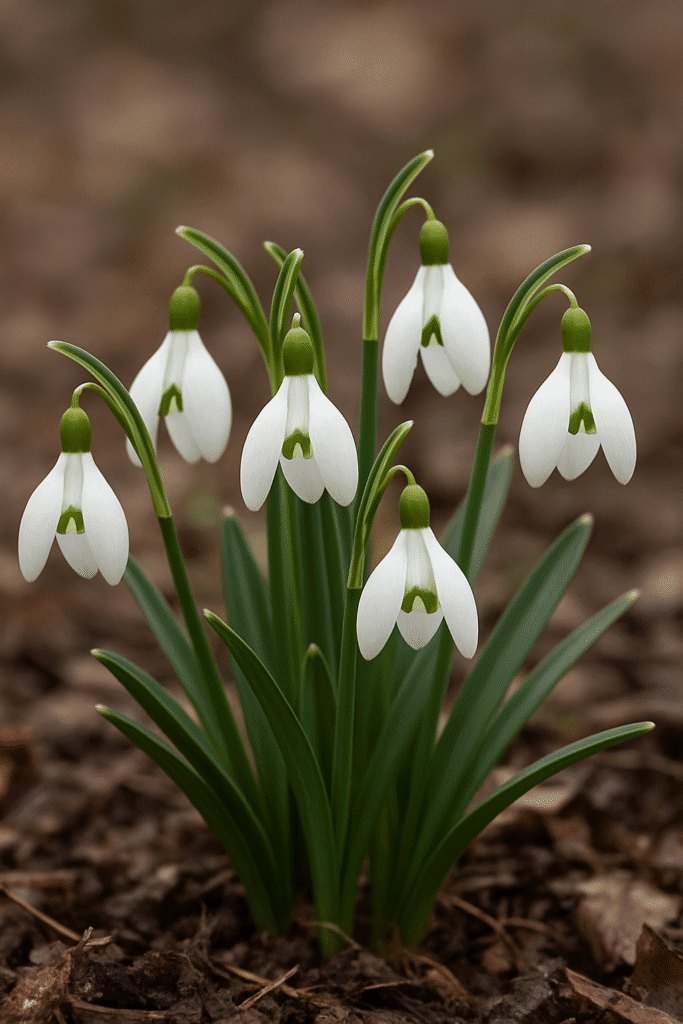
Crocus
- Late winter to early spring; vibrant purples, yellows, and whites; ideal for borders and lawns.
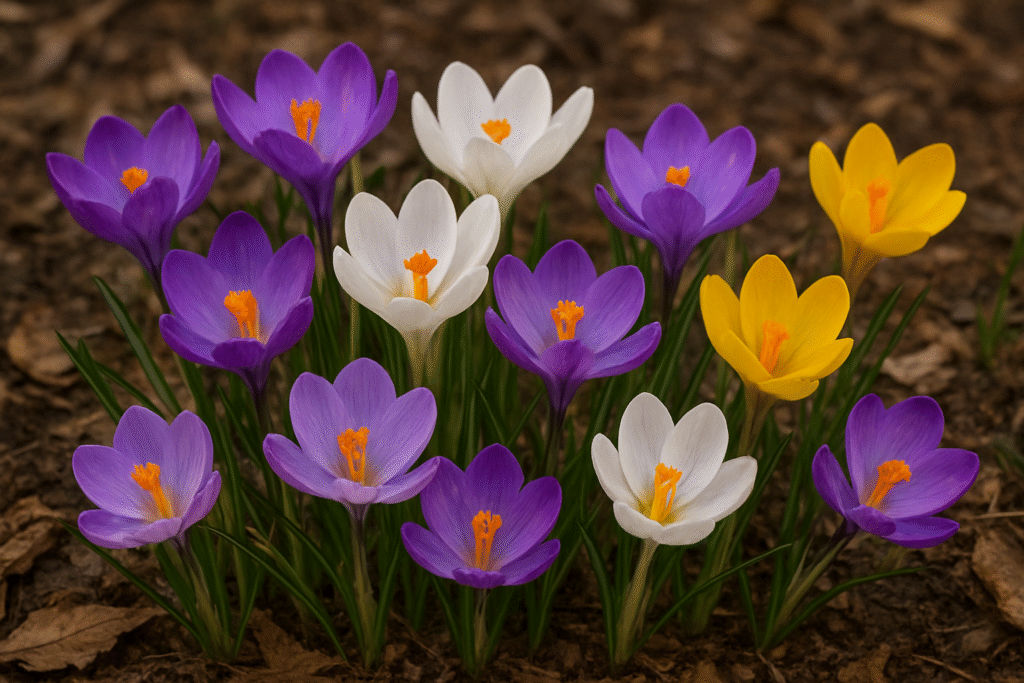
Scilla (Siberian Squill)
- Early spring; striking blue flowers, great for ground cover and naturalising.
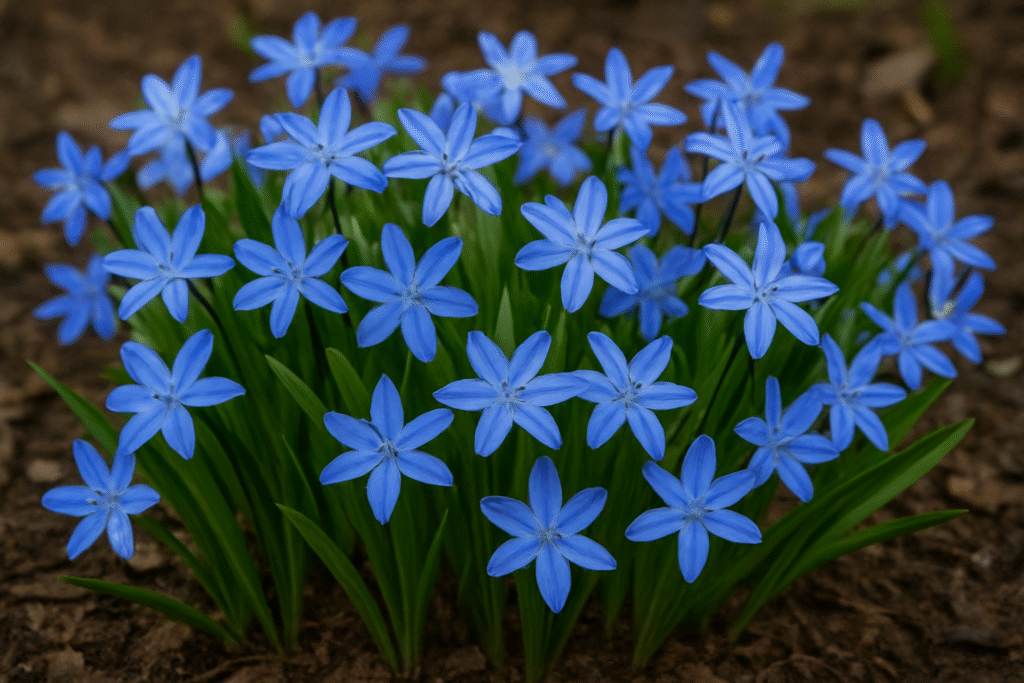
Mid-Spring Bulbs
Muscari (Grape Hyacinth)
- Early to mid-spring; deep blue clustered flowers, compact and perfect for edging or containers.
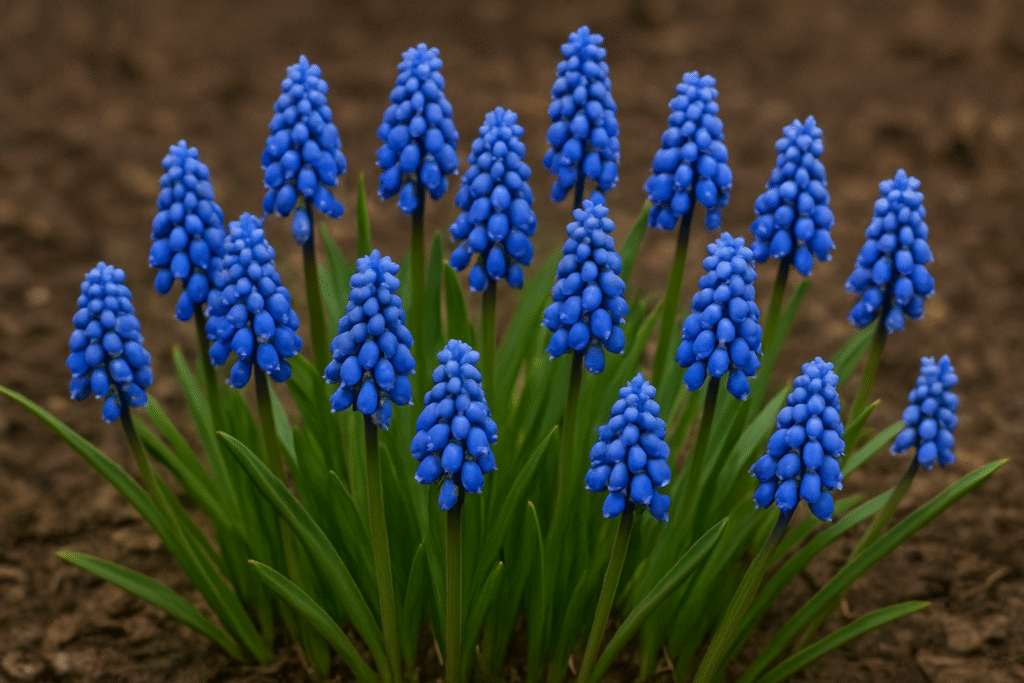
Daffodils (Narcissus)
- Early to mid-spring; cheerful yellow or white blooms, various heights; deer and rodent resistant.

Late Spring Bulbs
Tulips
- Mid to late spring; wide range of colours and shapes; show-stopping height and impact in beds or pots.
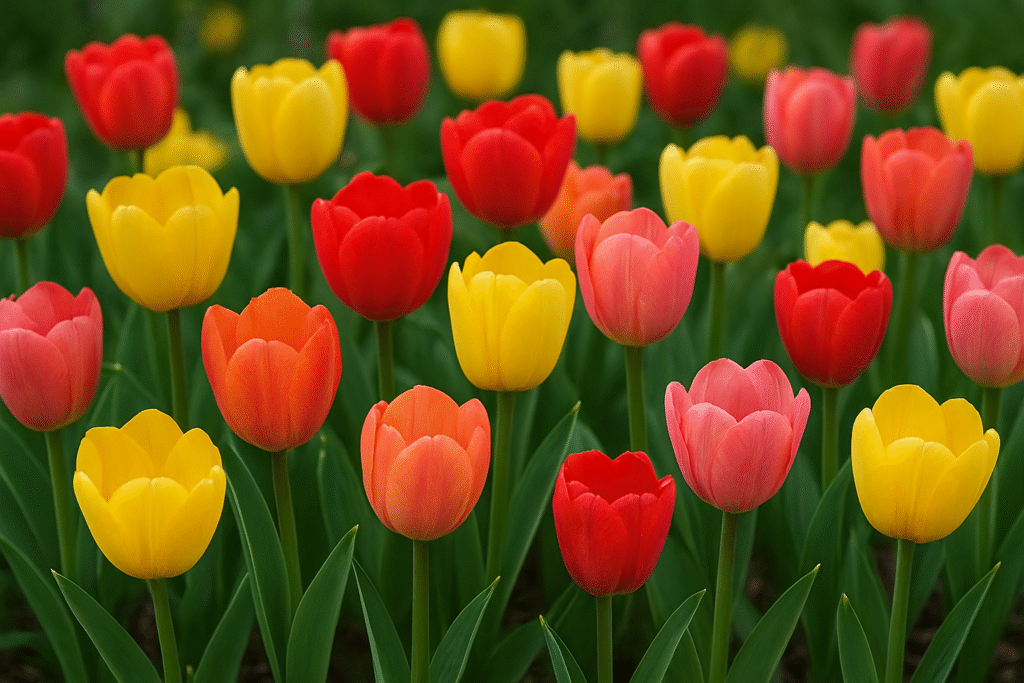
Hyacinths
- Mid to late spring; intensely fragrant, dense flower spikes in vibrant colours.

Alliums
- Late spring; tall, architectural blooms in purple, white, or pink; great for adding height and structure.

Where to Buy Spring Bulbs in the UK: Trusted Suppliers for Quality and Choice
When it comes to sourcing high-quality spring bulbs, my first choice is always Farmer Gracy. Their mission is to provide UK and EU gardeners with the most exclusive flower bulbs and bare-root perennials, all cultivated, processed, and packed sustainably and responsibly. I’ve always found their bulbs to be top quality and their selection truly inspiring.
Another selection of excellent options is Hayloft or Thompson & Morgan, both well-known UK suppliers offering a wide range of plants, seeds, and bulbs. Their reputation for quality and reliability makes them both a solid choice for gardeners of all levels.
If you prefer to see and select your bulbs in person, Hillier Garden Centre offer a fantastic range, and your local garden centre is also worth visiting for seasonal finds and expert advice.
When to Plant Spring Bulbs in the UK For The Best Results
Planting time matters a lot. Most spring-flowering bulbs need to get in the ground during Autumn so they can build roots and chill properly before waking up in spring.
Spring Flowering Bulbs
- (daffodils, crocus, hyacinths): plant by end of September.
Tulips
- Usually go in around November, after the first frosts but before the earth freezes.
Hardy Summer Bulbs
- (lilies, alliums, crocosmia): plant in September or October.
Tender Summer Bulbs
- (gladioli): plant in early spring, after danger of frost.
Autumn Flowering Bulbs
- (nerines): slip these in by late summer.
It’s vital to remember: bulbs need a period of cold dormancy, usually about 12 to 16 weeks under 9C to bloom properly. Skip this chilling and blooms can fail or end up stunted. (As recommended by Farmer Gracy)
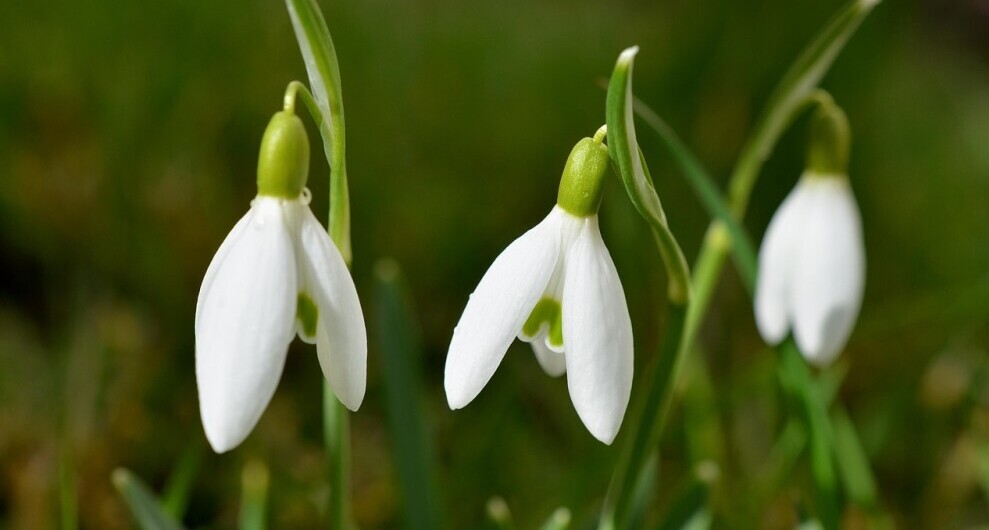
Garden Design Basics: Arranging Spring Bulbs
A thoughtful layout turns a few bulbs into something really eye-catching. My favourite way to design with bulbs is to think about their bloom times and how they’re grouped, not just spread out randomly.
Grouping Bulbs for Impact
- Plant early, mid, and late spring bloomers so something’s always flowering. Group bulbs in clusters or drifts (5 to 7 or more of one type) for a bolder impact. Small groups or single bulbs can look a bit lost.
Layering (‘Lasagna Planting’) for Continuous Colour
- Deeper bulbs (like tulips), then mid-depth (daffodils), then shallow bulbs (like crocuses) create a tiered, continuous display in one spot.
Hiding Foliage After Blooming
- How you arrange things also matters for hiding spent foliage later. I tuck bulbs among perennials or low groundcovers so that once the blooms fade, the dying leaves blend into new growth around them. For instance, planting bulbs near emerging hostas or under spreading hardy geraniums helps keep things looking lush as bulbs finish their season.

Planting Techniques For Healthy Bulbs: Depth, Spacing & Soil Tips
Getting bulbs in the ground the right way really pays off. Planting at the right depth keeps them insulated from cold and critters, and using well-drained soil gives them the best start for healthy growth.
Correct Planting Depth and Spacing
- Plant bulbs at a depth of about 2 to 3 times their height. So for a 2 inch bulb, dig about 4 to 6 inches deep. Space bulbs about 2x their width apart. This helps avoid crowding and gives roots plenty of room. (As recommended by Gardeners’ World)
- Point the “nose” (the shoot tip) up, roots down. Refill with soil, press gently, and water if the ground is dry.
Planting ‘In the Green’ for Sensitive Varieties
- Some bulbs, like snowdrops and bluebells, do best planted “in the green” (right after flowering, while leaves are still green), because their roots don’t like being dried out.
Choosing the Right Soil and Drainage
- Well-drained soil is a big deal for bulbs, as soggy spots mean rot. If your soil leans to clay, dig in sand or fine gravel along with compost to keep things loose. Sandy soils also need extra compost to boost fertility and retain just enough moisture for roots to establish.
- Consider testing your soil before planting. Slightly acidic to neutral soil (pH 6-7) suits most spring bulbs, while herbs like alliums can tolerate more alkaline ground. Adding organic matter each year keeps the soil crumbly and supports spring root growth.

Caring for Bulbs Through the Seasons
Once bulbs are in, they don’t need a ton of fussing over, but a little attention goes a long way. Here’s what keeps mine coming back strong season after season:
Watering and Feeding Tips
- Leave bulb foliage to die back naturally. Don’t tidy them up too soon, as the leaves produce energy for next year’s flowers.
- Water during dry spells in spring. Most bulbs are pretty drought-tolerant but would do better with moisture as they grow.
- Feed bulbs every 7 to 10 days with a high potassium fertiliser (tomato food works great) as shoots emerge and while flowering.
Protecting Bulbs from Pests and Disease
- Use wire mesh or chicken grit in beds to keep squirrels from digging bulbs up, especially tulips.
- Check for soft or rotten bulbs each year and remove any that look sick before disease can spread.
Squirrels vs. Tulips: My Biggest Bulb Battle (and How I Beat Them)
One of the biggest challenges I’ve faced with bulbs isn’t poor soil or bad weather—it’s squirrels. They may look adorable, but when it comes to bulbs, they’re little terrors, especially with tulips!
I remember planting tulip bulbs for a client using the lasagna method in large pots, carefully layering them for weeks of colour. The next morning, I arrived to find chaos: soil scattered everywhere, bulbs dug up, and half of them completely gone. A squirrel had discovered the pots, tossed out the compost, and happily helped itself to a feast of tulip bulbs.
It was frustrating (and slightly heartbreaking!)—but it taught me an important trick: protecting bulbs with chicken wire.After replanting, I placed a sheet of fine chicken wire over the soil surface, cutting it to size so it covered the entire pot. Once secured, I added a thin layer of compost on top to hide it. The bulbs grew through without issue, but the squirrels couldn’t dig down to get to them.
Since then, I’ve used the chicken wire method whenever I’m planting tulips in pots or vulnerable spots, and it’s worked brilliantly. Not only does it keep bulbs safe, but it saves you from waking up to a garden crime scene the next morning!
Dividing and Replanting for Long-Term Health
- Over time, many bulbs, especially naturalising types like grape hyacinths and snowdrops, multiply with barely any effort. This makes them great for people who want a lower-hassle design that still looks impressive for years with minimal work.
- Additionally, if bulbs in clumps seem crowded or stop flowering well, dig them up after the leaves have yellowed, separate the bulbs, and replant them around the garden. This helps rejuvenate old clumps and brings more colour to other spots. Occasional topdressing with compost also supports next year’s blooms.
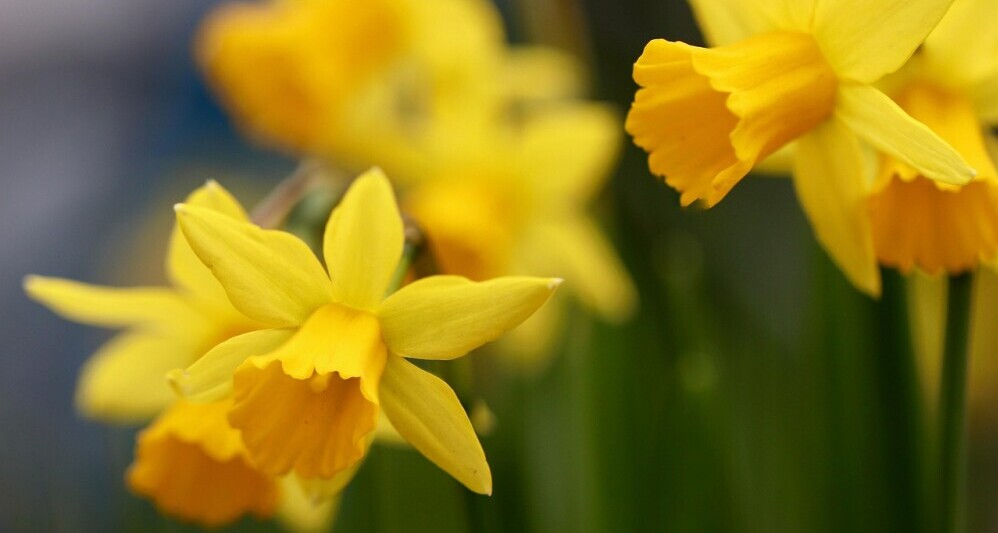
Growing Spring Bulbs in Containers
Containers are perfect for smaller spaces or for keeping showy displays closer to the house. Here’s how I handle pots for spring bulbs and make compact spaces just as lively as bigger gardens:
Choosing Pots and Soil Mixes
- Choose pots with drainage holes and fill with a compost and grit mix (about 3:1 ratio). John Innes No.2 works well for long-term plantings.
Layering Bulbs in Pots for Maximum Colour
- Follow the same depth rule as in borders, but pack bulbs fairly closely, usually about a bulb’s width apart. Layered planting works especially well in pots. Put big, late-flowering bulbs like tulips at the bottom, then mid-spring bloomers, and finally small early types like crocus or iris on top. This packs a lot of colour into a little space.
Protecting Container Bulbs in Winter
- Water well after planting and keep modestly moist while bulbs are active. Cut back watering as leaves yellow and eventually die back, but don’t let the pots dry out totally.
- Top dress with a high potassium fertiliser every 7 to 10 days through bloom time for the best flowers.
- Remember to move your pots to a sheltered location during the harshest winter weather, especially if temperatures plummet, to keep bulbs from getting frosted.
Troubleshooting: Common Bulb Problems & Quick Fixes
Rotten Bulbs and How to Avoid Them
- Always discard any mushy or mouldy bulbs before planting. Healthy bulbs feel firm and heavy for their size.
Preventing Pests and Wildlife Damage
- Watch out for slugs, snails, and squirrels. Physical barriers like wire mesh or mulches of sharp gravel can help a lot.
Dealing with Bulb Diseases
- Some bulbs are prone to issues like daffodil viruses, grey mould, or tulip fire, usually shown by streaked, spotted, or stunted leaves. Remove and bin affected plants (don’t compost).
If you’re planting late, get bulbs in the ground as soon as you can. Don’t hold them for next season. Late-planted bulbs might bloom weakly their first year but can recover after. Give them a boost with a handful of balanced fertiliser at planting time to support root growth.
Another quick tip: label your bulb plantings or snap photos in spring. This helps you track down where bulbs are so you don’t accidentally dig them up when adding summer plants.
The place I always recommend for tips, advice or ideas is the RHS website. Another good option is Hillier Garden Centre, either on their website or in a store.
FAQs: Spring Bulb Planting, Design & Care
When should you start planting spring bulbs?
Most spring-flowering bulbs go in during autumn, by the end of September for daffodils, crocuses, and hyacinths, and November for tulips. This gives bulbs time to grow roots and settle in before cold weather. In warm climates, store bulbs in your fridge (not with fruit) for 12 to 16 weeks and plant as soon as possible afterwards.
How do you arrange spring bulbs in a garden?
Grouping is key. Plant clusters or wide drifts (5 or more, ideally more for larger impact) for a showier look. Mix bloom times and heights for overlapping colour. Hide bulb foliage as it fades by mixing in perennials or groundcovers like hosta or hardy geraniums around your bulbs.
How deep do you plant spring bulbs?
A standard trick is to plant bulbs at a depth roughly 2 to 3 times their height, base of the bulb to soil line. This keeps them protected from frost and digging critters. Double-check the package guide for any exceptions, as some species like snowdrops prefer being planted a bit shallower.
What to plant on top of spring bulbs?
Groundcovers and shallow-rooted perennials like creeping phlox, sedum, or hardy geraniums work well. These keep the area looking tidy while bulb foliage dies back, and won’t interfere with the bulbs’ growth. You can also try small annuals for extra colour in late spring.
Ten Quick Facts for Spring Bulb Success
- Most spring bulbs need 12 to 16 weeks of cold to flower well.
- Always plant at a depth 2 to 3 times bulb height (base to soil surface).
- Mix early, mid, and late -lowering types for spring long colour.
- Good drainage is really important. Avoid soggy ground, and use raised beds or add sand to help with clay soils.
- Group bulbs in drifts or clusters (minimum 5 to 7 for visual impact).
- After flowering, hide dying leaves with perennials or groundcovers since bulbs need those leaves to recharge.
- Give bulbs at least 6 hours of sun in spring. Even shade lovers do better with some early sunlight.
- Layer bulbs at different planting depths for multistage blooms (“lasagna planting”).
- Protect from pests using wire mesh, grit, or by picking unappealing options like daffodils.
- Native or naturalising bulbs (grape hyacinths, snowdrops, certain daffodils) require very little upkeep after established.
Spring Bulb Planting Calendar (UK)
| Month | Task | Example Bulbs |
|---|---|---|
| September | Plant early spring-flowering bulbs | Daffodils, Crocus, Snowdrops, Hyacinths |
| October | Continue planting spring bulbs; start hardy summer bulbs | Alliums, Lilies, Muscari, Camassia |
| November | Plant tulips for best results | Tulips |
| December | Finish any late tulip planting (mild areas only) | Tulips |
| February | Plant bulbs ‘in the green’ for better establishment | Snowdrops, Bluebells, Winter Aconites |
| March | Plant tender summer-flowering bulbs after frost risk passes | Gladioli, Dahlias, Begonias |
| August | Plant autumn-flowering bulbs | Nerines, Colchicum |
Spring Bulb Comparison Table
| Bulb Variety | Bloom Time (UK) | Height Range | Colours & Qualities | Care Needs |
|---|---|---|---|---|
| Winter Aconites | Late winter–early spring | 5–10 cm (2–4 in) | Cheerful golden yellow; great for naturalising | Moist, well-drained soil; partial shade |
| Snowdrops | Late winter–early spring | 10–15 cm (4–6 in) | Pure white, delicate flowers; early pollinator | Plant ‘in the green’; likes moist woodland soil |
| Crocus | Late winter–early spring | 7–15 cm (3–6 in) | Purple, yellow, white; bright carpets of colour | Well-drained soil; full sun |
| Scilla | Early spring | 10–20 cm (4–8 in) | Intense blue blooms; spreads easily | Moist, fertile soil; sun or part shade |
| Muscari | Early–mid spring | 15–20 cm (6–8 in) | Clusters of grape-like blue flowers | Easy care; tolerates poor soil |
| Daffodils | Early–mid spring | 20–45 cm (8–18 in) | Yellow, white, or bi-colour; reliable and hardy | Sun or partial shade; avoid waterlogging |
| Hyacinths | Mid–late spring | 20–30 cm (8–12 in) | Highly fragrant, wide colour range | Fertile, well-drained soil; protect from frost |
| Tulips | Mid–late spring | 25–60 cm (10–24 in) | Huge variety of forms & colours | Plant in November; full sun; dislikes wet soils |
| Alliums | Late spring | 30–120 cm (12–48 in) | Dramatic globe flowers; great height in borders | Well-drained soil; sunny position |
| Camassia | Late spring–early summer | 60–90 cm (24–36 in) | Star-like blue or white blooms | Moist, fertile soil; sun or partial shade |
Why Planting Spring Bulbs Is My Favourite Gardening Tradition
For me, planting spring bulbs isn’t just about adding colour and structure—it’s a joyful ritual that marks the turning of the seasons. I first learned the art of timing, grouping, and caring for bulbs while working in the beautiful gardens of our historic Georgian town, and it’s a skill I’ve carried into my own garden ever since. Over the years, I’ve discovered that when bulbs are planted thoughtfully and cared for season after season, the display only gets better. Now, watching those first shoots push through the soil each spring has become one of my most cherished gardening traditions.
About the Author: A Self-Taught Gardener’s Journey in Hampshire
I grew up surrounded by the rural beauty of the Hampshire countryside, where my earliest dream was to work with animals. After finishing school, I studied at Sparsholt College and earned a National Diploma in Animal Management.
Life, as it often does, took me in a different direction. I built and ran another business, got married, and became a proud mum to three wonderful boys. After the birth of my youngest in 2020, I found myself at a crossroads, ready for a new career. Gardening—something that had always been a passion—was the natural choice.
I’ve now been working as a self-employed gardener in Hampshire for over five years, but my love for gardening began long before that. Growing up, I spent countless hours outside helping my parents, both keen gardeners (with three allotments!). Being outdoors, nurturing plants, and watching gardens transform with the seasons has always brought me joy.
While much of my knowledge has come through hands-on gardening experience, trial and error, and plenty of research, I’ve also relied heavily on trusted resources like the Royal Horticultural Society, which has guided me in becoming a confident, self-taught gardener.
I created Garden Nest Living to share everything I’ve learned and to help others discover the same satisfaction in creating and enjoying beautiful outdoor spaces. Whether you’re looking for UK gardening advice, self-taught gardening tips, or inspiration for your own garden, my goal is to inspire and guide you on your gardening journey.
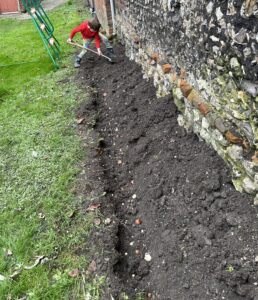

Bulb planting using the trench method, with my Son.
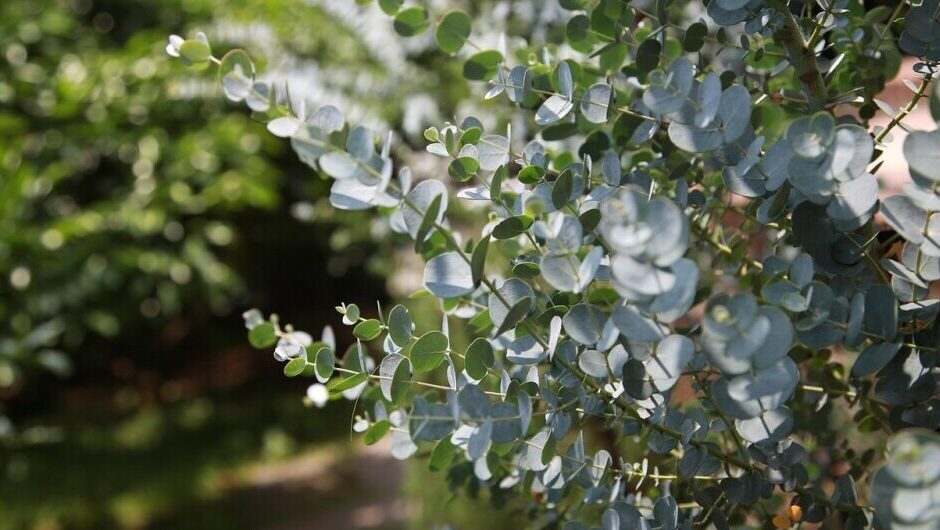
I have many gardens in my yard. My cousins plant them (I call them my little garden fairies). My vision for the gardens was to have year round blooms … in other words, when one type of plant stopped blooming, another type would start blooming. But, that isn’t what happened. This is an excellent tutorial on spring bulb planting. I do have a question though: I see my daffodils flowering each year, but the tulips no longer bloom. I recall finding an explanation for this, but I can’t remember what it was. What are your thoughts? Can I remedy this for next year?
It sounds like your ‘garden fairies’ are doing a wonderful job bringing your vision to life! You’re right — daffodils bloom reliably each year, but tulips can be trickier. Many modern tulips are bred for one spectacular season and don’t perennialise well.
Common reasons they stop blooming include:
Variety – Some, like Darwin Hybrids and species tulips, return better than others.Leaf removal – Cutting foliage too soon stops bulbs recharging.Poor drainage – Damp winter soil can weaken or rot bulbs.Low nutrients – Without feeding, bulbs may not store enough energy.
For better results next year, choose perennial tulip types, plant them deep in free-draining soil, feed weekly after flowering until leaves fade, and let foliage die back naturally. Some gardeners also plant fresh bulbs each autumn to guarantee a strong display.
Hi Jenny,
I loved this article — it’s so detailed and packed with useful info! The tables on planting times and the explanations of different bulb types are brilliant; they make planning a spring display so much easier.
Spring is such a beautiful time of the year with that reawakening of nature, so having your planner at the ready to plant out bulbs in sequence with nature is very handy.
I’m a huge gardening fan myself, and a couple of years ago I grew sunflowers over 8 foot tall — had to get on a ladder just to measure them, lol!
I grow both flowers and veggies, so I really appreciated all the tips on timing, layering blooms, and caring for bulbs throughout the seasons that you’ve shared.
It’s clear you’ve put a lot of thought into helping gardeners create colourful, thriving displays.
Thank you for such a thorough and inspiring guide — I can’t wait to put some of these ideas into practice in my own garden!
All the best
Cherie
Thank you so much for your thoughtful words — I’m really glad you found the article helpful! ???????? It sounds like you have a wonderful garden of your own. Eight-foot sunflowers — that’s incredible! They must have been a real showstopper.
I love that you’re growing both flowers and veggies — there’s something so rewarding about combining beauty and productivity in the same space. Planting bulbs in sequence really does bring so much joy in spring, and it’s exciting to hear you’re inspired to try some of the ideas in your own garden.
Wishing you lots of colour, growth, and happy hours outdoors — I’d love to hear how your next planting season goes!
Planting bulbs yearly if you love gardening is great, but if you want an easy garden, I am not sure that bulbs are the way to go as you need to keep replanting each year.
Bulbs grow the most beautiful flowers though and if you are a proud gardener, you will love these to brighten up your garden. I find it easier to plant my bulbs in pots in the garden, as I don’t need to bend so low, but you do need to redo each year.
I love your idea of planing the bulbs between ground cover so that the dying leaves can be hidden.
That’s a great point about planting bulbs in pots—it really does make things easier on the back! But just to add, you actually don’t need to replant most bulbs every year. Many varieties, like tulips, daffodils, and hyacinths, will come back on their own season after season, and some even multiply underground, giving you more blooms over time. So once they’re in the ground, you can often just enjoy the flowers each year without the extra work. Planting them between ground cover, like you mentioned, is such a smart way to keep the garden looking tidy as the leaves die back.
Thank you for writing the spring bulb planting design care guide, I found it extremely interesting and I learned a lot that i had not known.
Living in the state of Pennsylvania we also have many of the bulbs you mention in your article, I was wondering if the information would apply to Pennsylvania gardens as well in the UK? If you can help me with this information that would be cool, and if not that is alright
Jeff
Thank you so much for your kind words, Jeff—I’m delighted you enjoyed the spring bulb planting and design care guide! Many of the principles for planting and caring for bulbs apply just as well in Pennsylvania as they do in the UK, since popular bulbs like tulips, daffodils, and crocuses thrive in similar climates.
The main differences to keep in mind are your USA hardiness zone and the timing of seasonal changes. In Pennsylvania, you may have slightly colder winters or hotter summers depending on your region, so adjusting planting times by a few weeks can make a big difference. Otherwise, the general care tips should serve you well.
I hope that helps, and happy planting!
As someone new to planting spring bulbs this year, I found this post incredibly helpful! I just completed my first major planting session, and I was pleasantly surprised by how enjoyable the process was. It’s a fun mix of gardening and puzzle-solving.
I was definitely worried about burying my little crocuses too deep, but the 2-3 times depth rule gives me confidence that they will be properly insulated this winter.
I’m particularly excited about experimenting with potting. Since I have a smaller garden, maximizing the space in my containers is essential, and the idea of achieving a succession of color from one pot sounds brilliant. I used a mix of compost and grit, as you suggested, so I’m keeping my fingers crossed for a spectacular spring display!
This piece made me smile because it reminded me of my childhood back home. We didn’t have tulips or daffodils, but I remember planting sorghum and beans with my mother after the first rains. We pressed each seed into the wet soil with quiet hope, not knowing if it would all survive. That same faith in the unseen is what I feel when reading about spring bulbs breaking through the cold ground. Gardening, in any land, is really an act of trust.
There’s a saying from where I come from, “The tree remembers the hand that planted it.” Every flower that blooms in your garden is a gentle memory of your care. You’re not just growing colours for spring, you’re growing moments that speak back to you each year, reminding you that life returns in its own time.
—John